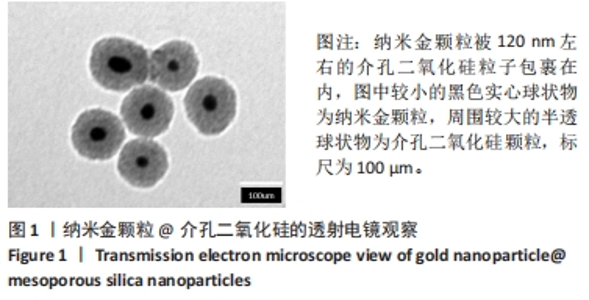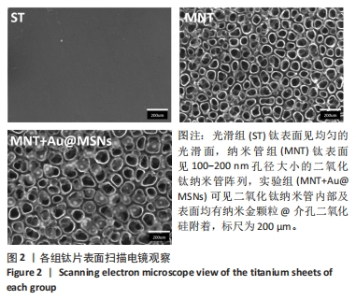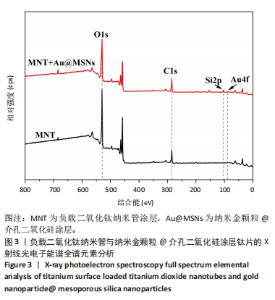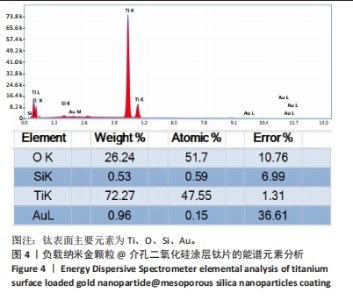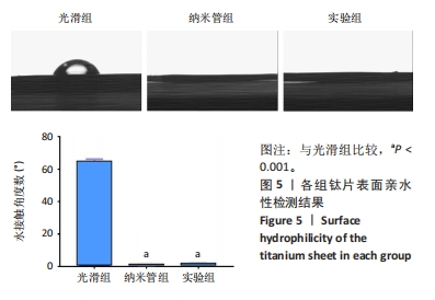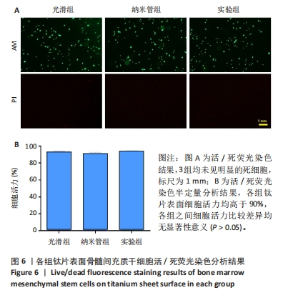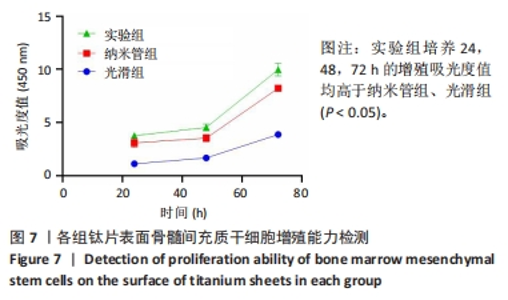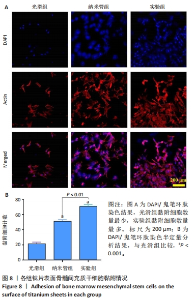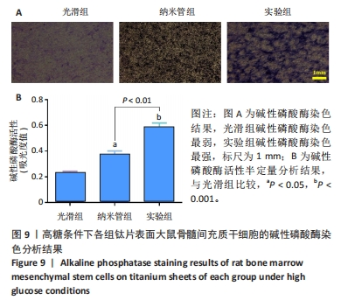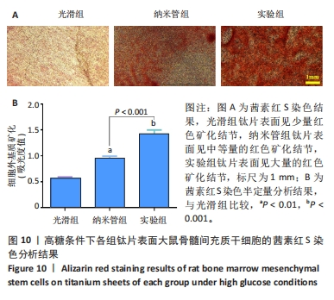Chinese Journal of Tissue Engineering Research ›› 2025, Vol. 29 ›› Issue (22): 4694-4701.doi: 10.12307/2025.454
Previous Articles Next Articles
Gold nanoparticle @ mesoporous silica modified titanium implants promote osteogenic differentiation under high glucose conditions
Deng Yunyi1, 2, 3, Chen Shichao1, 2, 3, Luo Mingdong2, 3, Li Ruotong2, 3, Lan Xiaorong2, 3, Yu Ke1, 2, 3, Li Guangwen1, 2, 3
- 1Department of Implantology, Affiliated Stomatological Hospital, Southwest Medical University, Luzhou 646000, Sichuan Province, China; 2Oral & Maxillofacial Reconstruction and Regeneration of Luzhou Key Laboratory, Luzhou 646000, Sichuan Province, China; 3Institute of Stomatology, Southwest Medical University, Luzhou 646000, Sichuan Province, China
-
Received:2024-03-20Accepted:2024-05-25Online:2025-08-08Published:2024-12-05 -
Contact:Li Guangwen, Doctoral candidate, Attending physician, Department of Implantology, Affiliated Stomatological Hospital, Southwest Medical University, Luzhou 646000, Sichuan Province, China; Oral & Maxillofacial Reconstruction and Regeneration of Luzhou Key Laboratory, Luzhou 646000, Sichuan Province, China; Institute of Stomatology, Southwest Medical University, Luzhou 646000, Sichuan Province, China Yu Ke, MD, Associate professor, Department of Implantology, Affiliated Stomatological Hospital, Southwest Medical University, Luzhou 646000, Sichuan Province, China; Oral & Maxillofacial Reconstruction and Regeneration of Luzhou Key Laboratory, Luzhou 646000, Sichuan Province, China; Institute of Stomatology, Southwest Medical University, Luzhou 646000, Sichuan Province, China -
About author:Deng Yunyi, Master, Department of Implantology, Affiliated Stomatological Hospital, Southwest Medical University, Luzhou 646000, Sichuan Province, China; Oral & Maxillofacial Reconstruction and Regeneration of Luzhou Key Laboratory, Luzhou 646000, Sichuan Province, China; Institute of Stomatology, Southwest Medical University, Luzhou 646000, Sichuan Province, China -
Supported by:Sichuan Provincial Science and Technology Department Key Research and Development Project, No. 22YFS0634 (to LXR); Luzhou Science and Technology Bureau Key Research and Development Plan (Surface), No. 2022-SYF-33 (to LGW); Natural Science Key Project of Southwest Medical University, No. 2022ZD015 (to LGW); Hospital Level Key Project of Stomatology Hospital Affiliated to Southwest Medical University, No. 2022Z01 (to LGW); Natural Science Foundation of Sichuan Province (General Program), No. 2024NSFSC0680 (to LGW)
CLC Number:
Cite this article
Deng Yunyi, Chen Shichao, Luo Mingdong, Li Ruotong, Lan Xiaorong, Yu Ke, Li Guangwen. Gold nanoparticle @ mesoporous silica modified titanium implants promote osteogenic differentiation under high glucose conditions[J]. Chinese Journal of Tissue Engineering Research, 2025, 29(22): 4694-4701.
share this article
Add to citation manager EndNote|Reference Manager|ProCite|BibTeX|RefWorks
| [1] LONTCHI-YIMAGOU E, SOBNGWI E, MATSHA TE, et al. Diabetes mellitus and inflammation. Curr Diab Rep. 2013;13(3):435-444. [2] DE OLIVEIRA PGFP, BONFANTE EA, BERGAMO ETP, et al. Obesity/metabolic syndrome and diabetes mellitus on peri-implantitis. Trends Endocrinol Metab. 2020;31(8):596-610. [3] GRAVES DT, DING Z, YANG Y. The impact of diabetes on periodontal diseases. Periodontol 2000. 2020;82(1):214-224. [4] MONJE A, CATENA A, BORGNAKKE WS. Association between diabetes mellitus/hyperglycaemia and peri-implant diseases: Systematic review and meta-analysis. J Clin Periodontol. 2017;44(6):636-648. [5] HAN X, MA J, TIAN A, et al. Surface modification techniques of titanium and titanium alloys for biomedical orthopaedics applications: A review. Colloids Surf B Biointerfaces. 2023;227:113339. [6] 刘鹏,樊博,邹磊,等.钛基植入物抗菌/促成骨双功能表面改性策略研究进展[J].中国修复重建外科杂志,2023,37(10):1300-1313. [7] ZHU L, LUO D, LIU Y. Effect of the nano/microscale structure of biomaterial scaffolds on bone regeneration. Int J Oral Sci. 2020;12(1):6. [8] ZHAO R, CHEN S, YUAN B, et al. Healing of osteoporotic bone defects by micro-/nano-structured calcium phosphate bioceramics. Nanoscale. 2019;11(6):2721-2732. [9] HAGHWERDI F, KHOZAEI RAVARI M, TAGHIYAR L, et al. Application of bone and cartilage extracellular matrices in articular cartilage regeneration. Biomed Mater. 2021;16(4). doi: 10.1088/1748-605X/ac094b. [10] ZHANG T, GAO Y, CUI W, et al. Nanomaterials-based Cell Osteogenic Differentiation and Bone Regeneration. Curr Stem Cell Res Ther. 2021; 16(1):36-47. [11] GONG T, XIE J, LIAO J, et al. Nanomaterials and bone regeneration. Bone Res. 2015;3:15029. [12] FATTAHI R, MOHEBICHAMKHORAMI F, TAGHIPOUR N, et al. The effect of extracellular matrix remodeling on material-based strategies for bone regeneration: Review article. Tissue Cell. 2022;76:101748. [13] DENG C, XU C, ZHOU Q, et al. Advances of nanotechnology in osteochondral regeneration. Wiley Interdiscip Rev Nanomed Nanobiotechnol. 2019;11(6):e1576. [14] LEE KX, SHAMELI K, YEW YP, et al. Recent Developments in the Facile Bio-Synthesis of Gold Nanoparticles (AuNPs) and Their Biomedical Applications. Int J Nanomedicine. 2020;15:275-300. [15] FAN J, CHENG Y, SUN M. Functionalized Gold Nanoparticles: Synthesis, Properties and Biomedical Applications. Chem Rec. 2020;20(12):1474-1504. [16] QIAO M, TANG W, XU Z, et al. Gold nanoparticles: promising biomaterials for osteogenic/adipogenic regulation in bone repair. J Mater Chem B. 2023;11(11):2307-2333. [17] LI J, LI JJ, ZHANG J, et al. Gold nanoparticle size and shape influence on osteogenesis of mesenchymal stem cells. Nanoscale. 2016;8(15):7992-8007. [18] KANKALA RK, HAN YH, NA J, et al. Nanoarchitectured Structure and Surface Biofunctionality of Mesoporous Silica Nanoparticles. Adv Mater. 2020;32(23):e1907035. [19] KANKALA RK, HAN YH, XIA HY, et al. Nanoarchitectured prototypes of mesoporous silica nanoparticles for innovative biomedical applications. J Nanobiotechnology. 2022;20(1):126. [20] SHI M, ZHOU Y, SHAO J, et al. Stimulation of osteogenesis and angiogenesis of hBMSCs by delivering Si ions and functional drug from mesoporous silica nanospheres. Acta Biomater. 2015;21:178-189. [21] WANG J, ZHANG Y, LIU L, et al. Combined chemo/photothermal therapy based on mesoporous silica-Au core-shell nanoparticles for hepatocellular carcinoma treatment. Drug Dev Ind Pharm. 2019;45(9): 1487-1495. [22] WANG H, CHEN F, HU A, et al. Harmine loaded Au@MSNs@PEG@Asp6 nano-composites for treatment of spinal metastasis from lung adenocarcinoma by targeting ANXA9 in vivo experiment. Transl Lung Cancer Res. 2023;12(5):1062-1077. [23] ZHOU L, LIU G, WANG Y, et al. AuNP and ssDNA capped mesoporous silica nanoparticles for laser controlled drug release. RSC Adv. 2019; 9(60):34958-34962. [24] ESKANDARI P, BIGDELI B, PORGHAM DARYASARI M, et al. Gold-capped mesoporous silica nanoparticles as an excellent enzyme-responsive nanocarrier for controlled doxorubicin delivery. J Drug Target. 2019; 27(10):1084-1093. [25] ZHANG Y, KONG N, ZHANG Y, et al. Size-dependent Effects of Gold Nanoparticles on Osteogenic Differentiation of Human Periodontal Ligament Progenitor Cells. Theranostics. 2017;7(5):1214-1224. [26] STICH T, ALAGBOSO F, KŘENEK T, et al. Implant-bone-interface: Reviewing the impact of titanium surface modifications on osteogenic processes in vitro and in vivo. Bioeng Transl Med. 2021;7(1):e10239. [27] LUO M, ZHAO Z, YI J. Osteogenesis of bone marrow mesenchymal stem cell in hyperglycemia. Front Endocrinol (Lausanne). 2023;14:1150068. [28] LI Y, TENG D, SHI X, et al. Prevalence of diabetes recorded in mainland China using 2018 diagnostic criteria from the American Diabetes Association: national cross sectional study. BMJ. 2020;369:m997. [29] AJAMI E, BELL S, LIDDELL RS, et al. Early bone anchorage to micro- and nano-topographically complex implant surfaces in hyperglycemia. Acta Biomater. 2016;39:169-179. [30] CHOUIRFA H, BOULOUSSA H, MIGONNEY V, et al. Review of titanium surface modification techniques and coatings for antibacterial applications. Acta Biomater. 2019;83:37-54. [31] MA L, LI G, LEI J, et al. Nanotopography Sequentially Mediates Human Mesenchymal Stem Cell-Derived Small Extracellular Vesicles for Enhancing Osteogenesis. ACS Nano. 2022;16(1):415-430. [32] LI H, HUANG J, WANG Y, et al. Nanoscale Modification of Titanium Implants Improves Behaviors of Bone Mesenchymal Stem Cells and Osteogenesis In Vivo. Oxid Med Cell Longev. 2022;2022:2235335. [33] HU P, GAO Q, ZHENG H, et al. The Role and Activation Mechanism of TAZ in Hierarchical Microgroove/Nanopore Topography-Mediated Regulation of Stem Cell Differentiation. Int J Nanomedicine. 2021;16: 1021-1036. [34] MA L, KE W, LIAO Z, et al. Small extracellular vesicles with nanomorphology memory promote osteogenesis. Bioact Mater. 2022; 17:425-438. [35] 张贤俊,赵锡江.钛螺钉表面含硅二氧化钛纳米管层的体内成骨性能[J].中国组织工程研究,2021,25(16):2461-2465. [36] WANG K, JIN H, SONG Q, et al. Titanium dioxide nanotubes as drug carriers for infection control and osteogenesis of bone implants. Drug Deliv Transl Res. 2021;11(4):1456-1474. [37] 张利兴,田昂,李锡,等.TiO2纳米管/羟基磷灰石载万古霉素涂层的释药性及生物毒性[J].中国组织工程研究,2021,25(10):1500-1506. [38] CHOI SY, SONG MS, RYU PD, et al. Gold nanoparticles promote osteogenic differentiation in human adipose-derived mesenchymal stem cells through the Wnt/β-catenin signaling pathway. Int J Nanomedicine. 2015;10:4383-4392. [39] RASOOL N, NEGI D, SINGH Y. Thiol-Functionalized, Antioxidant, and Osteogenic Mesoporous Silica Nanoparticles for Osteoporosis. ACS Biomater Sci Eng. 2023;9(6):3535-3545. [40] REN B, WAN Y, LIU C, et al. Improved osseointegration of 3D printed Ti-6Al-4V implant with a hierarchical micro/nano surface topography: An in vitro and in vivo study. Mater Sci Eng C Mater Biol Appl. 2021; 118:111505. [41] SUN X, LIN H, ZHANG C, et al. Improved Osseointegration of Selective Laser Melting Titanium Implants with Unique Dual Micro/Nano-Scale Surface Topography. Materials (Basel). 2022;15(21):7811. [42] ZHOU J, XIONG S, LIU M, et al. Study on the influence of scaffold morphology and structure on osteogenic performance. Front Bioeng Biotechnol. 2023;11:1127162. [43] SAKTHI DEVI R, GIRIGOSWAMI A, SIDDHARTH M, et al. Applications of Gold and Silver Nanoparticles in Theranostics. Appl Biochem Biotechnol. 2022;194(9):4187-4219. |
| [1] | Aikepaer · Aierken, Chen Xiaotao, Wufanbieke · Baheti. Osteogenesis-induced exosomes derived from human periodontal ligament stem cells promote osteogenic differentiation of human periodontal ligament stem cells in an inflammatory microenvironment [J]. Chinese Journal of Tissue Engineering Research, 2025, 29(7): 1388-1394. |
| [2] | Sun Yuting, Wu Jiayuan, Zhang Jian. Physical factors and action mechanisms affecting osteogenic/odontogenic differentiation of dental pulp stem cells [J]. Chinese Journal of Tissue Engineering Research, 2025, 29(7): 1531-1540. |
| [3] | Ge Xiao, Zhao Zhuangzhuang, Guo Shuyu, Xu Rongyao. HOXA10 gene-modified bone marrow mesenchymal stem cells promote bone regeneration [J]. Chinese Journal of Tissue Engineering Research, 2025, 29(36): 7701-7708. |
| [4] | Liu Chengyuan, Guo Qianping. Differential effects of kartogenin on chondrogenic and osteogenic differentiation of rat and rabbit bone marrow mesenchymal stem cells [J]. Chinese Journal of Tissue Engineering Research, 2025, 29(35): 7490-7498. |
| [5] | Zhang Fei, Zuo Jun. Inhibition of hypertrophic scar in rats by beta-sitosterol-laden mesoporous silica nanoparticles [J]. Chinese Journal of Tissue Engineering Research, 2025, 29(34): 7301-7309. |
| [6] | Tang Haoxu, Liang Yingjie, Li Ce, Ding Penglin, Qian Minlong, Yuan Lingli. Deferoxamine alleviates the inhibitory effect of glucocorticoids on osteogenic differentiation [J]. Chinese Journal of Tissue Engineering Research, 2025, 29(32): 6821-6827. |
| [7] | Liu Xun, Ouyang Hougan, Pan Rongbin, Wang Zi, Yang Fen, Tian Jiaxuan . Optimal parameters for physical interventions in bone marrow mesenchymal stem cell differentiation [J]. Chinese Journal of Tissue Engineering Research, 2025, 29(31): 6727-6732. |
| [8] | Pan Yu, Zhao Renfeng, Li Xingping, Zhang Chengdong, Shi Feng, Pu Chao, Luo Xuwei, Xiao Dongqin. Iron overload induces ferroptosis in osteoblast precursor cells and inhibits osteogenic differentiation [J]. Chinese Journal of Tissue Engineering Research, 2025, 29(30): 6381-6390. |
| [9] | Chen Pinrui, Xue Yiyuan, Pei Xibo. Fe3O4@ZIF-8 nanoparticles affect osteogenic differentiation of bone marrow mesenchymal stem cells under magnetic stimulation [J]. Chinese Journal of Tissue Engineering Research, 2025, 29(23): 4841-4850. |
| [10] | Han Nianrong, Huang Yifei, Akram · Osman, Liu Yanlu, Hu Wei . Programmed death receptor 1 inhibits osteogenic differentiation of rat bone marrow mesenchymal stem cells in a high glucose environment [J]. Chinese Journal of Tissue Engineering Research, 2025, 29(19): 3961-3967. |
| [11] | Ye Zhimao, Hui Jiuying, Zhong Xiaoxia, Mai Yuying, Li Hao. Mogroside V promotes osteogenic differentiation of bone marrow mesenchymal stem cells by modulating M1 polarization of macrophages under high glucose condition [J]. Chinese Journal of Tissue Engineering Research, 2025, 29(19): 3968-3975. |
| [12] | Gao Feng, Wang Jiliang, Wang Hongbo, Yang Yongsheng, Liu Yuan, Fu Su. Passage-associated senescence decreases osteogenic activity of MC3T3-E1 cells via primary cilia [J]. Chinese Journal of Tissue Engineering Research, 2025, 29(18): 3741-3746. |
| [13] | Wang Wenchi, Xia Tian, Wu Ruiqi, Liang Haohan, Ni Zhenyang, Zhang Zhenhao, Li Zhenxing, Chen Guanghui, Su Han. Molecular mechanism of active ingredients of Ligustri Lucidi Fructus against osteoporosis [J]. Chinese Journal of Tissue Engineering Research, 2025, 29(18): 3856-3867. |
| [14] | Zhang Wanli, Bai Tao, Han Nianrong, Akram·Osman, Liu Yanlu, Huang Yifei, Hu Wei. Mechanism by which programmed cell death protein 1 influences osteoblast differentiation under high-glucose conditions [J]. Chinese Journal of Tissue Engineering Research, 2025, 29(17): 3521-3528. |
| [15] | Qin Jingjie, Guo Zige, Li Rui, Ma Shiqing, Lu Ruijie, Li Mengjun. Modification with bone forming peptide 1 and polydopamine coating to improve bioactivity of polyetheretherketone surface [J]. Chinese Journal of Tissue Engineering Research, 2025, 29(16): 3318-3325. |
| Viewed | ||||||
|
Full text |
|
|||||
|
Abstract |
|
|||||
